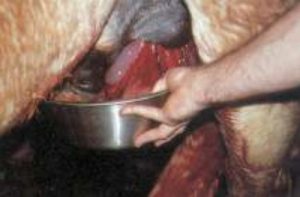Large animal wounds
Body cavity involvement
Due to the risk of pneumothorax and life-threatening peritonitis/pleuritis wounds potentially involving the thoracic or abdominal cavity should be managed as emergencies. Body cavity damage should be suspected in any wound over the torso that goes deeper than 1-2 cms, particularly if the patient is showing abnormal respiratory movements, nostril flaring, elevated heart rate or change in mucous membrane color.
These wounds should be closed or covered with saran wrap or vaseline impregnated gauze (to keep air out). and transported to the nearest referral hospital.

Pneumothorax is rapidly life threatening for horses. Cattle usually have a complete mediastinum (air doesn’t leak across to the other side) and can continue just fine on one lung.
If the abdominal cavity is penetrated, evisceration of intestines is common. Any exposed intestines should be rinsed and forced back into the abdominal cavity. The hole should be closed or wrapped to minimize movement of any other intestines out of the wound prior to transport to a referral hospital. Gravity works and intestines can slide out of small holes. Take the steps needed to close any holes at least for transport.

Peritonitis and pleuritis are treatable but require hospitalization, iv antibiotics and potentially surgery. Prognosis depends on the time line before effective treatment.
Key Takeaways
Body cavity involvement is a bad prognosis. Get these animals referred after closing or covering any chest wounds and ensuring intestines stay where they belong (even if it means anesthetizing the horse to temporarily close the wound).
Resources
How to Manage Penetrating Wounds in the Field, AAEP Proceedings, 2012; provided by The Blood Horse

